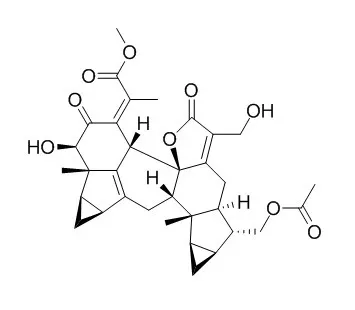| Cell Research: |
| PLoS One. 2016 Mar 24;11(3):e0152012. | | Shizukaol D, a Dimeric Sesquiterpene Isolated from Chloranthus serratus, Represses the Growth of Human Liver Cancer Cells by Modulating Wnt Signalling Pathway.[Pubmed: 27010735 ] | Natural products have become sources of developing new drugs for the treatment of cancer. To seek candidate compounds that inhibit the growth of liver cancer, components of Chloranthus serratus were tested.
METHODS AND RESULTS:
Here, we report that Shizukaol D, a dimeric sesquiterpene from Chloranthus serratus, exerted a growth inhibition effect on liver cancer cells in a dose- and time-dependent manner. We demonstrated that Shizukaol D induced cells to undergo apoptosis. More importantly, Shizukaol D attenuated Wnt signalling and reduced the expression of endogenous Wnt target genes, which resulted in decreased expression of β-catenin.
CONCLUSIONS:
Collectively, this study demonstrated that Shizukaol D inhibited the growth of liver cancer cells by modulating Wnt pathway. |
|
| Structure Identification: |
| Chem Pharm Bull (Tokyo). 2011;59(10):1281-4. | | Spicachlorantins G-J, new lindenane sesquiterpenoid dimers from the roots of Chloranthus spicatus.[Pubmed: 21963639] |
METHODS AND RESULTS:
Four new lindenane sesquiterpenoid dimers, spicachlorantins G-J (1-4), were isolated from the roots of Chloranthus spicatus together with seven known compounds, including chloramultilide A, shizukaol B, Shizukaol D, shizukaol F, shizukaol P, chlorahololide D, and cycloshizukaol A. The planar structures of the new compounds were established by 1D-, 2D-NMR, and MS analyses.
CONCLUSIONS:
The absolute configurations of these compounds were determined by analyzing rotating Overhauser enhancement and exchange spectroscopy (ROESY) and circular dichroism (CD) spectra. |
|






 Cell. 2018 Jan 11;172(1-2):249-261.e12. doi: 10.1016/j.cell.2017.12.019.IF=36.216(2019)
Cell. 2018 Jan 11;172(1-2):249-261.e12. doi: 10.1016/j.cell.2017.12.019.IF=36.216(2019) Cell Metab. 2020 Mar 3;31(3):534-548.e5. doi: 10.1016/j.cmet.2020.01.002.IF=22.415(2019)
Cell Metab. 2020 Mar 3;31(3):534-548.e5. doi: 10.1016/j.cmet.2020.01.002.IF=22.415(2019) Mol Cell. 2017 Nov 16;68(4):673-685.e6. doi: 10.1016/j.molcel.2017.10.022.IF=14.548(2019)
Mol Cell. 2017 Nov 16;68(4):673-685.e6. doi: 10.1016/j.molcel.2017.10.022.IF=14.548(2019)